
First Alert carbon monoxide detectors are reliable, user-friendly devices designed to protect homes from CO poisoning. They meet UL standards and feature digital displays, silence buttons, and optional wired or battery power for flexible installation. These detectors are essential for early detection of carbon monoxide, ensuring safety and peace of mind.
1.1 Overview of First Alert CO Detectors
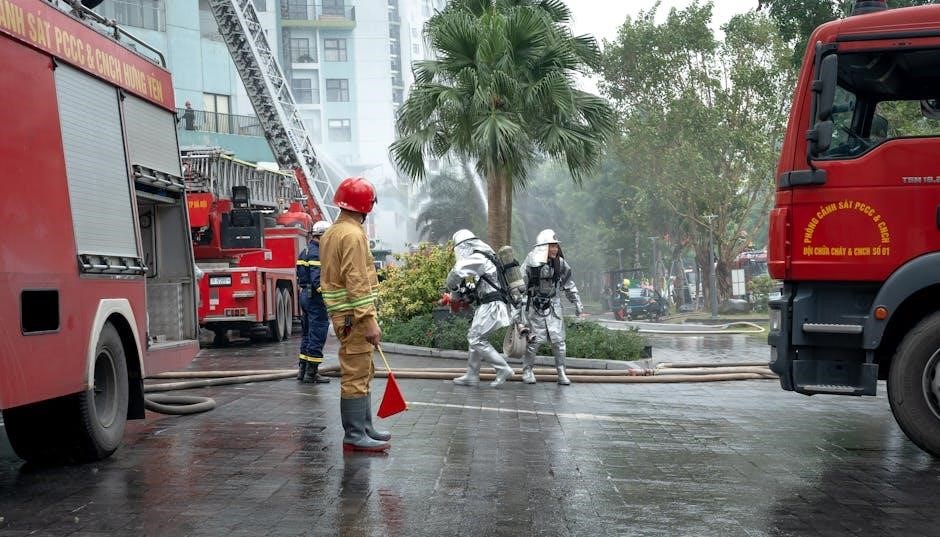
First Alert carbon monoxide detectors are highly reliable safety devices designed to provide early warnings of dangerous CO levels. Models like the CO710, FCD2DD, and SC9120B offer advanced features such as digital displays, silence buttons, and battery or plug-in power options. These detectors are user-friendly and designed for residential use, ensuring comprehensive protection. They often include interconnectivity with other safety devices, enhancing overall home safety. First Alert CO detectors are trusted for their accuracy and durability, making them a top choice for homeowners seeking reliable carbon monoxide monitoring solutions.
1.2 Importance of Carbon Monoxide Safety
Carbon monoxide (CO) safety is crucial as CO is a colorless, odorless gas that can be deadly in high concentrations. It is produced by combustion sources like cars, heaters, and fuel-burning appliances. CO detectors like First Alert’s models are vital because they detect CO levels before they become dangerous, providing early warnings to prevent poisoning. Symptoms of CO exposure include headaches, dizziness, and nausea, which can escalate to life-threatening conditions if not addressed promptly.
First Alert detectors, such as the CO710 and FCD2DD, offer reliable monitoring with features like digital displays, silence buttons, and battery or plug-in options. They meet UL safety standards, ensuring effectiveness and reliability. Proper installation and maintenance, as outlined in user manuals, are essential for optimal performance. Interconnectivity with other safety devices enhances home protection, making First Alert detectors a key component in safeguarding against CO threats.
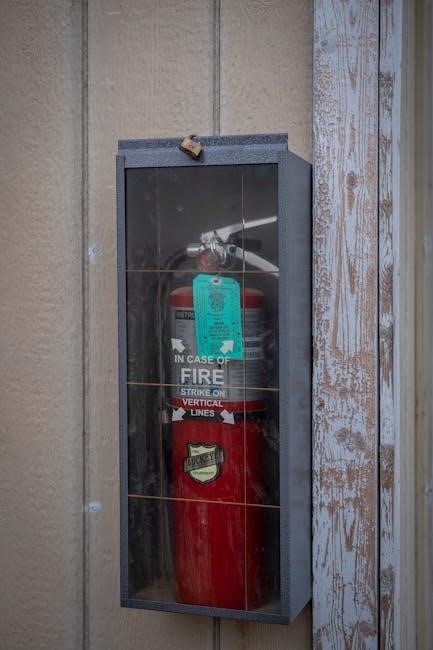
Installation Requirements
Install First Alert CO detectors on every level of your home and near sleeping areas. Place them at least 5 feet above the floor to ensure accurate detection. Avoid installing near direct sunlight, moisture, or fuel-burning appliances to prevent false alarms.
2.1 Choosing the Right Location for Your Detector
Proper placement of your First Alert carbon monoxide detector is crucial for effective monitoring. Install detectors on every level of your home, including basements and garages, and near sleeping areas for optimal coverage. Ensure the detector is at least 5 feet above the floor to avoid false alarms from ground-level interference. Avoid installing near direct sunlight, moisture, or fuel-burning appliances like furnaces or water heaters, as these can interfere with sensor accuracy. For ceilings with peaks or slopes, place the detector within 3 feet of the highest point. This strategic placement ensures the detector can accurately detect CO levels and provide timely alerts, enhancing your home’s safety and your family’s peace of mind.
2.2 Step-by-Step Installation Instructions
Begin by selecting a suitable location for your First Alert CO detector, ensuring compliance with the manufacturer’s guidelines. For battery-powered models, insert the batteries correctly, ensuring the polarity matches the diagram. For hardwired detectors, turn off the power at the circuit breaker before starting. Remove the mounting bracket from the detector and screw it into the wall or ceiling using the provided hardware. Once secure, attach the detector to the bracket. For plug-in models, simply insert the detector into a nearby outlet. After installation, test the detector using the test button to ensure proper functionality; Refer to the user manual for specific instructions tailored to your detector model. Proper installation ensures accurate CO detection and reliable performance.
2.3 Placement Recommendations for Optimal Coverage
For optimal coverage, place First Alert carbon monoxide detectors near sleeping areas and on every level of your home. Install them within 10 feet of combustion sources like furnaces or water heaters. On peaked or gabled ceilings, detectors should be within 3 feet of the peak, measured horizontally. Avoid areas with high humidity or extreme temperatures. Ensure detectors are at least 5 feet away from fuel-burning appliances to minimize false alarms. Proper placement ensures comprehensive protection and accurate detection of carbon monoxide levels in your home.

Features of the First Alert CO Detector
First Alert CO detectors feature a digital display, silence button, and peak level memory. They offer interconnectivity with other safety devices and come with a 10-year sealed battery.
3.1 Battery and Power Options
First Alert CO detectors offer versatile power options to ensure uninterrupted monitoring. Many models come with a 10-year sealed battery, eliminating the need for frequent replacements. Others are plug-in units, providing consistent power with optional battery backup for during outages. Some detectors also feature wired connectivity, integrating seamlessly with home electrical systems. These power options ensure reliable performance and adaptability to different household needs, offering users peace of mind with minimal maintenance.
3.2 Digital Display and Readouts
First Alert CO detectors feature a digital display that provides clear, real-time readings of carbon monoxide levels in parts per million (ppm). This feature allows users to monitor the air quality accurately and respond promptly to potential threats. The display is easy to read, with a bright, backlit screen that ensures visibility even in low-light conditions. Some models also include a memory function, storing the highest CO level detected to help identify recurring issues. The digital display enhances user awareness and simplifies troubleshooting, making it an essential tool for maintaining a safe environment. This feature is particularly useful for tracking CO levels over time and ensuring the detector is functioning correctly.
3.3 Silence Feature and Reset Functionality
The First Alert carbon monoxide detector includes a convenient silence feature that allows users to temporarily mute the alarm during false triggers, such as cooking fumes or smoke. This feature is activated by pressing a designated button, ensuring the alarm does not disturb the household unnecessarily. Additionally, the reset functionality enables the detector to revert to its normal monitoring state after an alarm has been silenced or after CO levels have returned to safe ranges. Some models automatically reset once the CO levels drop below dangerous thresholds, while others may require manual intervention. These features enhance user convenience and ensure the detector remains operational and reliable for continuous protection. Proper use of these functions is essential for maintaining home safety and avoiding unnecessary disruptions.
3.4 Interconnectivity with Other Safety Devices
First Alert carbon monoxide detectors offer advanced interconnectivity with other safety devices, enhancing home protection. Many models can wirelessly connect to other First Alert alarms, ensuring a unified response to potential threats. When one detector triggers, all interconnected devices sound the alarm, providing comprehensive coverage throughout the home. This feature is particularly useful in multi-story or large homes, where a single alarm might not be heard everywhere. Some detectors also integrate with smart home systems, allowing users to receive alerts on their smartphones via apps like the Onelink App. This seamless communication ensures that dangerous conditions are identified and addressed promptly, offering an additional layer of safety and peace of mind for residents.

Operating the Detector
Operating the First Alert CO detector involves turning it on, testing its functionality, and understanding its alarm sounds and indicators. Regular testing ensures reliability, and the reset feature allows users to silence alarms and reset the device after an event.
4.1 Turning On and Testing the Detector
To turn on the First Alert carbon monoxide detector, ensure it is properly installed and powered. For battery-powered models, insert the batteries correctly. Plug-in detectors should be securely connected to a wall outlet. Once powered, the detector will perform a self-test, indicated by a brief flash or beep. To test the detector manually, press and hold the test/silence button until the alarm sounds. This confirms the device is operational. Additionally, check for a steady green light, which indicates normal function. Regular testing ensures the detector is ready to alert you in case of rising CO levels. Always follow the manual instructions for specific models, such as the CO710 or FCD2DD, to ensure proper activation and testing procedures.
4.2 Understanding the Alarm Sounds and Indicators
First Alert carbon monoxide detectors use distinct sounds and visual indicators to signal potential dangers. When CO levels rise, the alarm emits a loud, high-pitched beep pattern, typically four beeps followed by a pause. This sequence repeats until the threat is resolved. The detector may also flash a red light during an alarm to enhance visibility. A steady green light indicates normal operation, while a yellow or red light signals a problem, such as low battery or a malfunction. Some models, like the CO710, include voice alerts for added clarity. Familiarize yourself with these signals to respond appropriately during an emergency. Always consult your specific model’s manual for detailed explanations of its unique indicators and alarm patterns.
4.3 Resetting the Detector After an Alarm
To reset your First Alert carbon monoxide detector after an alarm, press and hold the “Test/Silence” button until the alarm stops. This feature also silences nuisance alarms caused by cooking or steam. For models with a digital display, the reset process may vary slightly, but most require the same button press. After resetting, ensure the environment is safe by ventilating the area and addressing the source of CO if detected. If the alarm sounds again, evacuate immediately and contact emergency services. Always refer to your specific model’s manual for precise reset instructions, as some detectors may have additional steps or requirements. Resetting ensures the device is ready to monitor for future threats. Remember, a green light indicates the detector is functioning normally after a reset.
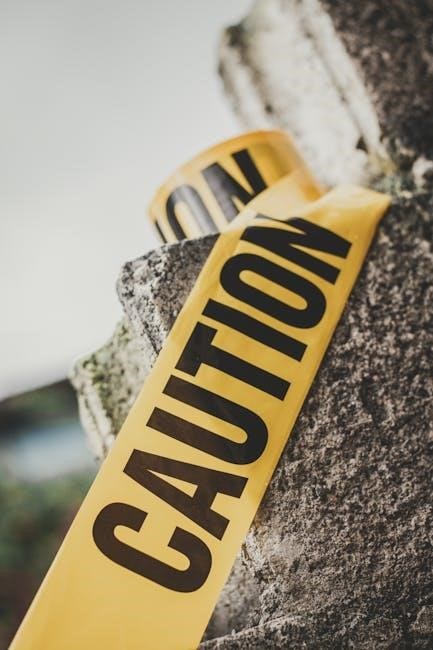
Maintenance and Care
Regular maintenance ensures your First Alert carbon monoxide detector operates effectively. Clean the detector monthly using a soft brush or vacuum to remove dust. Check the battery level for battery-powered models or ensure a stable power supply for hardwired units. Test the detector weekly by pressing the “Test” button to confirm proper function. Replace batteries annually or when the low-battery alert sounds. For models with a digital display, refer to the manual for specific reset and testing instructions. Avoid exposing the detector to harsh chemicals or extreme temperatures. Replace the detector every 7-10 years or as indicated by the manufacturer. Proper care extends the lifespan and reliability of your CO detector, ensuring continuous protection for your home and family. Always follow the manufacturer’s guidelines for maintenance to guarantee optimal performance and safety. Regular inspections and timely replacements are crucial for maintaining your detector’s effectiveness in detecting carbon monoxide threats. By adhering to these maintenance routines, you can trust your First Alert detector to provide consistent and accurate alerts, safeguarding your household from potential CO hazards. Additionally, interconnectivity features in some models allow for integrated safety systems, enhancing overall home protection. Remember, a well-maintained detector is your first line of defense against carbon monoxide risks. Stay vigilant and proactive in ensuring your detector’s readiness at all times. Your safety depends on it.
5.1 Cleaning the Detector for Proper Function
Cleaning your First Alert carbon monoxide detector is essential for maintaining its accuracy and reliability. Use a soft, dry cloth or a vacuum cleaner with a gentle brush attachment to remove dust and debris from the exterior and vents. Avoid using chemicals, water, or abrasive materials, as they may damage the sensor or housing. Never touch the sensor or internal components, as oils from skin can interfere with performance. For models with removable covers, take them off and clean inside carefully. Regular cleaning prevents false alarms and ensures the detector can detect CO levels accurately. Refer to the manual for specific cleaning instructions tailored to your model. A clean detector is more likely to function correctly during emergencies, providing critical protection for your home and family.
5.2 Replacing Batteries or Checking Power Sources
Regularly checking and maintaining the power source of your First Alert carbon monoxide detector is crucial for reliable performance. For battery-powered models, replace the batteries annually or when the low-battery warning chirps. Use the recommended battery type, typically AA or 9V, and ensure they are installed correctly with the polarity aligned. For hardwired detectors, verify that the unit is securely connected to a working power supply. Models with sealed 10-year batteries require no replacement but should be tested monthly. Always refer to the user manual for specific instructions, as improper battery installation can lead to device malfunction. A functioning power source ensures continuous monitoring and alarm capability, providing essential protection against carbon monoxide threats.
5.3 Regular Testing and Inspection Schedule
Regular testing and inspection of your First Alert carbon monoxide detector are essential to ensure its reliability and effectiveness. Test the detector monthly by pressing the test button to verify proper operation. Additionally, check the visual indicators, such as the red (alarm) and green (normal operation) lights, to confirm functionality. Inspect the detector for dust or debris that may interfere with its performance and clean it as needed. Perform a full system test annually, including simulating conditions that could trigger an alarm. If your detector is interconnected, test the communication between devices. Always refer to the user manual for specific testing instructions. Regular maintenance ensures your detector remains accurate and provides consistent protection against carbon monoxide threats.
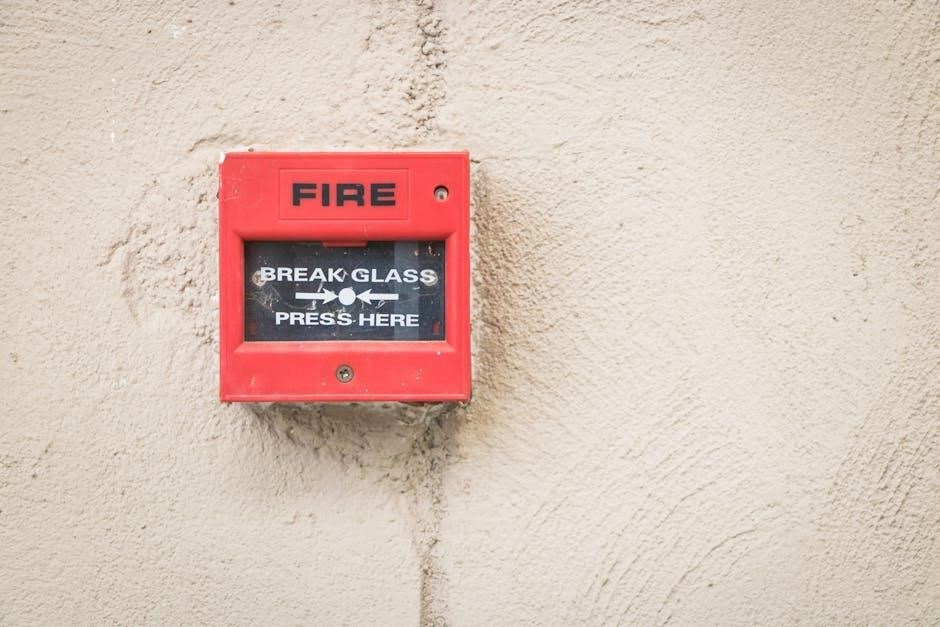
Troubleshooting Common Issues
Identify error codes and resolve them by referencing the manual. Address false alarms by checking for dust or proximity to cooking areas. Ensure proper power sources and reset functionality for optimal performance.
6.1 Identifying and Resolving Error Codes
Error codes on First Alert CO detectors indicate specific issues. For instance, a steady red light may signal a malfunction, while a blinking red light could mean low battery. Refer to the manual for a comprehensive list of codes and solutions. To resolve these issues, ensure the detector is clean and free from dust. If the problem persists, check the power source or replace the batteries. For models with digital displays, error codes like “E1” or “E2” often relate to sensor or power issues. Always follow the troubleshooting steps outlined in the manual to restore your detector’s functionality and ensure your safety.
6.2 Addressing False Alarms and Nuisance Signals
False alarms on First Alert CO detectors can occur due to dust, cooking fumes, or steam. To address this, press the “Silence” button to temporarily mute the alarm. Ensure the detector is clean by gently vacuuming or wiping it with a soft cloth. Relocate the detector if it’s near potential sources of interference, such as kitchens or bathrooms. Avoid placing it directly above fuel-burning appliances like furnaces or water heaters. If the issue persists, check for proper installation and ensure the detector is not expired. Regular maintenance, like replacing batteries or checking power sources, can also prevent nuisance signals. Always refer to the manual for specific troubleshooting steps to resolve false alarms effectively.
6.3 Repairing or Replacing a Faulty Detector
If your First Alert CO detector is malfunctioning, first check for error codes or unusual behavior like continuous beeping without CO presence. Refer to the user manual to identify the issue. If the detector is faulty, ensure it is disconnected from power or batteries before attempting repairs. For hardwired models, switch off the circuit breaker and disconnect wires carefully. If the detector cannot be repaired, replace it with a compatible model. When installing a new detector, follow the installation instructions precisely to ensure proper function. Always test the detector after replacement to confirm it works correctly. If unsure, contact First Alert customer support for assistance. Regularly updating or replacing faulty detectors ensures continuous protection against carbon monoxide threats.
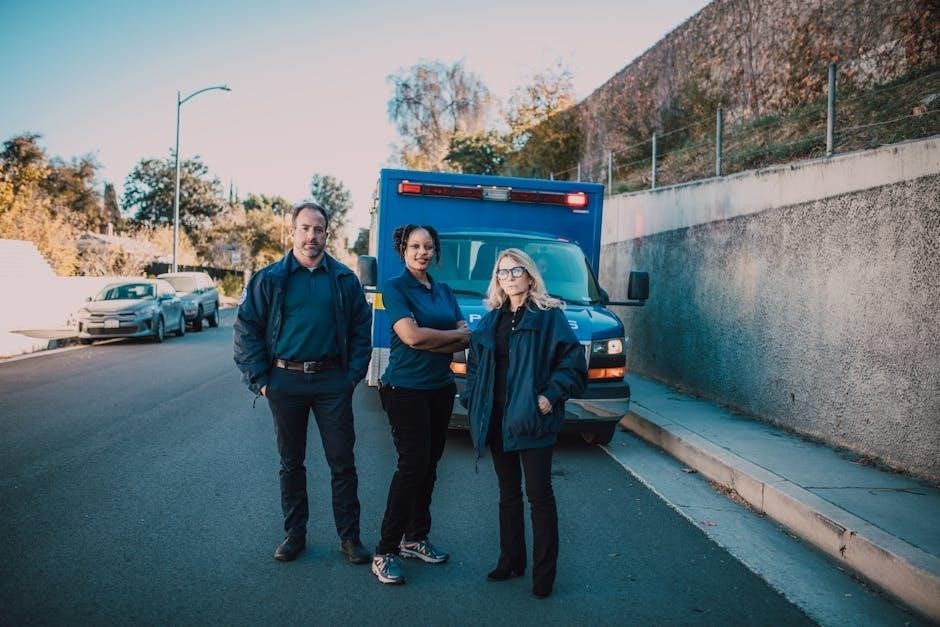

Safety Tips and Best Practices
Never ignore the alarm—evacuate and investigate. Ensure detectors are installed on every level and near sleeping areas. Test monthly and stay informed about CO sources like fuel-burning appliances.
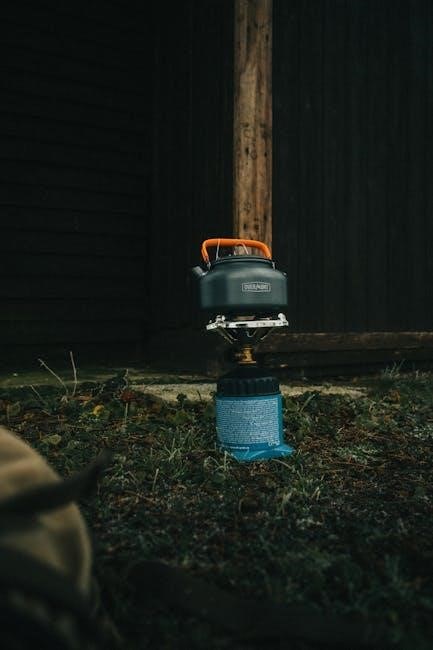
7.1 What to Do When the Alarm Sounds
Stay calm and act quickly. Immediately evacuate all occupants, including pets, from the premises. Do not investigate the source of CO yourself. Open windows for ventilation if time allows. Call 911 or your local emergency number from a safe location. Never ignore the alarm, as it signals a potential life-threatening situation. If anyone experiences symptoms like headaches, dizziness, or nausea, seek medical attention immediately. After evacuating, check for CO sources, such as malfunctioning appliances or blocked vents. Only return home when authorities confirm it is safe. Remember, CO is odorless and invisible, so trust your detector and prioritize safety.
7.2 Identifying Potential Carbon Monoxide Sources
Carbon monoxide (CO) is produced by incomplete combustion of fuels like natural gas, propane, charcoal, and wood. Common sources include faulty furnaces, water heaters, generators, and vehicles in attached garages. Clogged vents, chimneys, or flues can trap CO indoors. Additionally, improperly installed or maintained fuel-burning appliances, such as stoves, fireplaces, or boilers, can release CO. Portable generators and grills used indoors are also significant risks. Look for signs like soot streaks near appliances or vents, excessive condensation on windows, or yellow or flickering flames in burners, which may indicate CO hazards. Identifying these sources early is crucial for preventing dangerous CO buildup and ensuring safe living conditions.
7.3 When to Replace Your Carbon Monoxide Detector
Replace your First Alert carbon monoxide detector every 10 years, as the sensor’s accuracy diminishes over time. Look for an end-of-life warning, such as a steady beep or a flashing light, indicating the detector needs replacement. Additionally, replace the detector if it shows physical damage, corrosion, or if it no longer responds to test stimuli. If you’re unsure of the detector’s age or history, especially in a new home, consider replacing it immediately. Always check the expiration date on the unit or consult the user manual for specific guidelines. Upgrading to a newer model with advanced features like digital displays or smart connectivity can also enhance safety and convenience. Replace promptly to ensure reliable protection against carbon monoxide threats.

